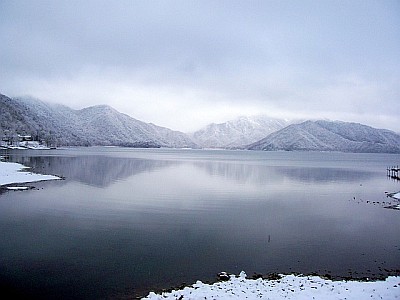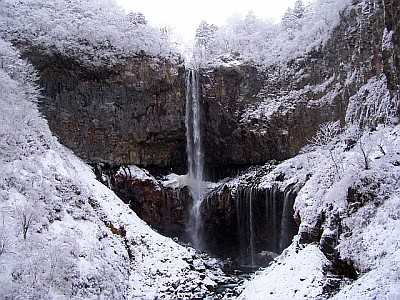
Japan
Nikko![[Unesco]](/images/unesco-logo.gif)
![[+]](/images/icone-etoile.png)
This is a nice outing for a day in moutains and forests outside Tokyo. ![]() Tokyo-Nikko route info
Tokyo-Nikko route info
To travel Tokyo-Nikko, you can either take a classic train or the shinkansen, the Japanese high speed train, up to Utsunomiya and then a local train. Whatever the solution, do not forsee less than a 1h30-2h journey...
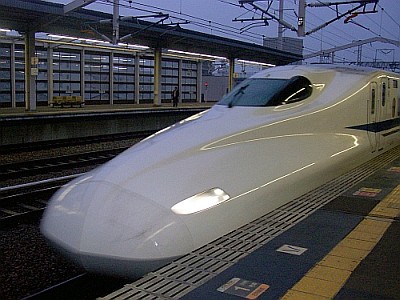
The Shinto-Buddhist temples are in a particular style called gongen-zukuri, and they are sublime. I was lucky during my trip because the snow had just fallen and it created a kind of magic in scenery already beautiful. In addition to visiting the temples we can extend the visit by going to Chuzenji lake and Kegon Falls (by bus, with a winding and beautiful road). And note that Nikko means "sunlight".
Temples and shrines
Shinkyo sacred bridge
This red lacquered wooden bridge was built at the place where the monk Shodo Shonin, founder of the temples of Nikko, crossed the river supported by two huge snakes taking the form of a bridge (in the year 766).
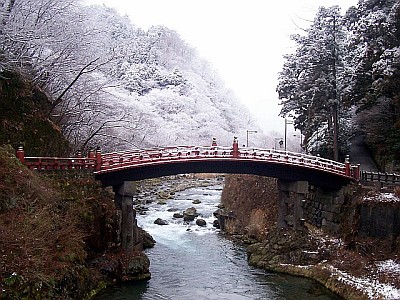
Tosho-gu shrine
It is the mausoleum of the first shogun of the dynasty Tokugawa : Tokugawa Ieyasu who completed the unification of Japan under his authority and moved the shogunate in Edo (Tokyo)...
He asked to be buried at his death in Nikko in order to protect Edo from invisible enemies supposedly coming from the north. Like any Shinto shrine we enter through a torii.
On a first gate, there are sculptures of two guardians ni-oh, one with the mouth open pronounces the sound "ah" (beginning) while the second,
with the mouth closed pronounces the sound "um" (the end). Buddhism derives for some of its roots from Hinduism (by syncretism) in which the sound "Aum" is the sound of creation
of the world emerging from chaos. On a next door was the Komas (half-dog, half-lion) who are also guardians.
See also the 5-storey pagoda, the sacred stable with a woodcarving of the three wise monkeys, from Chinese mythology.
The wisdom of the three monkeys is : "not hear what I should not hear", "not say that I should not say", "not see what I should not see". Their names are : Kikazaru,
Iwazaru and Mizaru. Thus they represent the three most important principles of the Japanese Tendai Buddhist sect, found here by syncretism. Note : the Indian Gandhi always
carried with him an engraving of this three monkeys...
Yomeimon gate is wonderful !
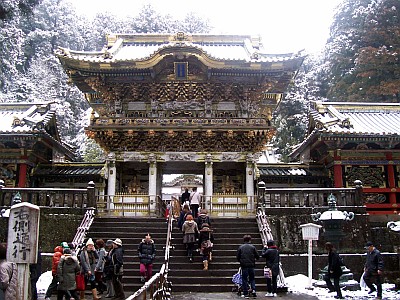
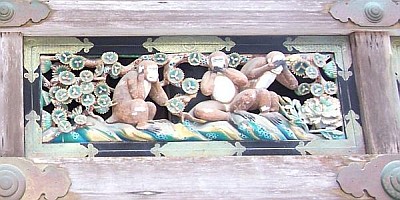
Taiyuin-byo shrine
It is the mausoleum of the famous shogun Tokugawa Iemitsu (1603-1661) who closed Japan to the world (this closed period lasted more than two centuries and is called sakoku).
He was the grand-son of the first shogun of the dynasty Tokugawa :
Tokugawa Ieyasu. He first ordered the Tosho-gu shrine for his grandfather and then Taiyuin-byo for himself. ![]() shogun
shogun
The term shogun refers to a title of commander in chief with the power of governing the country by delegation of the emperor (dairi). Initially, this title was granted by the emperor during wars and was temporary. But in 1192, the samurai Minamoto-no-Yoritomo noticing the weakness of the emperor took the title of shogun to run the country. He kept the emperor in Kyoto but established a military power in Kamakura. This was that military power which then really ruled Japan and shogunate became the official political system that year 1192. Though marked by several succession wars, the period of shogunate lasted until 1867 when Meiji emperor took over (it is called the Meiji restoration or Meiji Ishin).
In the 16th century, leaders Nobunaga Oda and Toyotomi Hideyoshi began the unification of Japan on their behalf. It is also during this century that the Portuguese came in Japan and brought Christian religion. Hideyoshi promulgated the first ban of Christianity in 1587 and expelled the Jesuits. He died in 1598 leaving his clan weakened after failing the invasion of Korea and a war of succession ensued. It was finally Tokugawa Ieyasu (1543-1616) who won the decisive battle of Sekigahara (the battle that decided the fate of the nation) in 1600. He took the title of shogun and completed the unification of Japan.
The Shogun Tokugawa Iemitsu (1604-1651), grand-son of the former one is the shogun under which Japan was closed on itself. He first turned against Japanese Christians, mostly present around Nagasaki, by persecuting them and crushing the rebellion of Shimabara. He then banned trade with the Portuguese (who opened a trade route between Macao and Japan) under penalty of death. He criticized them for having brought the Christian faith in Japan. Only Chinese and Dutch could still trade with Japan, but it remained highly regulated. On the other hand, the refinement of Nikko shrines (mausoleums for himself and his grandfather) is due to this shogun.
Nitenmon gate marking the entrance of the shrine is superb ! You can also see several statues of deities and guardians.
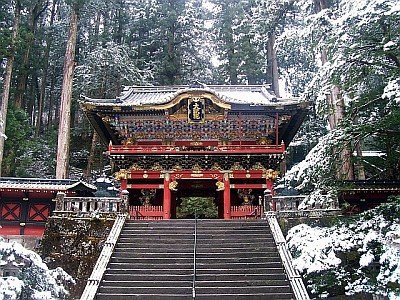
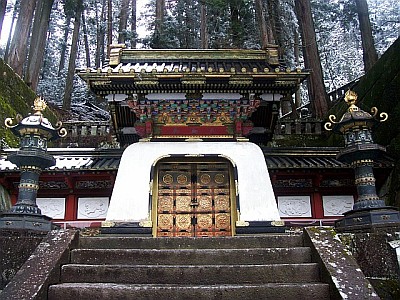
Futarasan shrine
We enter the shrine after crossing the bronze torii on which is attached a sacred rope (shimenawa) made with plaited rice straw. We can also see shides (strips of paper folded in zigzag) hung on the rope. The torii indicates the entrance to a Shinto shrine. The rope is used to delimit the sacred territory of the kami. The shides represent the kami. In this shrine kami from mount Nantai, mount Nyotai and mount Taro are worshipped. Cans of sake are offered to the kami by companies or individuals.
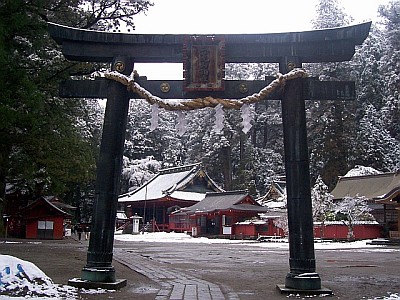
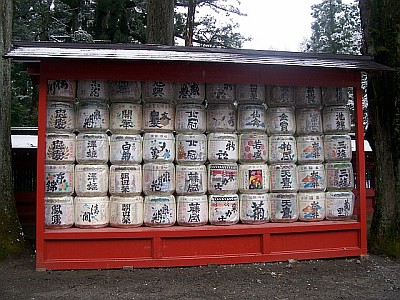
Rinno-ji temple
To change from Shinto shrines, here is a Buddhist temple in which there are three major statues : one of Senju Kannon (Avalokitesvara -Sanskrit name- represented with 1,000 arms), one of the Buddha Amida (Amitabha in Sanskrit) and one of Bato Kannon with a horse head (It is Avalokitesvara again but represented as the protector of the animal world). Avalokitesvara (Kannon in Japanese) is the bodhisattva of compassion and she has 33 different forms or representations ! She is worshipped a lot in Japan and the name of the company Canon derives from hers. Too bad, taking pictures is forbidden...
Every year (on April, the 2nd) the Gohan Shiki, ceremony of "forced rice eaters" is held in this temple. During this ceremony, Buddhist monks have notables eat large bowls of rice till the last grain... This would ward off bad luck. I remember having seen Japanese TV "game" where people had to eat enormous quantities of food as quickly as possible, at risk of becoming seriously ill... Is there a link with this ceremony that could have led to this "game" idea ?...
See also the column sorinto in which are stored 1,000 volumes of Buddhist scriptures, and a garden that reproduces lake Biwa (near Kyoto) sceneries in miniature.
Chuzenji lake and Kegon falls
Beaware of the climate ! When I got there on the beginning of march there was snow but luckily with the warm weather the road was passable...
It is also a great complement to the visit of the temples 30 km (18.6 miles) away from Nikko. The road is beautiful, and how
convenient : lake Chuzenji and Kegon Falls, a 97 m (318 feet) waterfalls, are nearby. We can also stop a few stops earlier to get to a viewpoint
(which was closed because of too much snow on the day of my visit).
![]() Nikko-Chuzenji lake route infos
Nikko-Chuzenji lake route infos
It takes 50 minutes to get to Chuzenji lake by bus from Nikko. Schedules are available at the information office located on the street from the station to the bridge Shinkyo (on the left in this direction). These bus schedules will certainly be helpful, especially if a stop at the viewpoint is planned. Thus, to do everything in one day, it is better to come early in the morning, for example, by devoting morning's time to visiting temples and shrines and afternoon's time to going to lake Chuzenji and Kegon falls.
